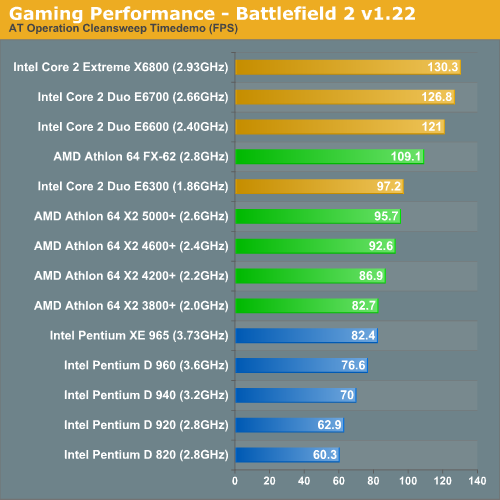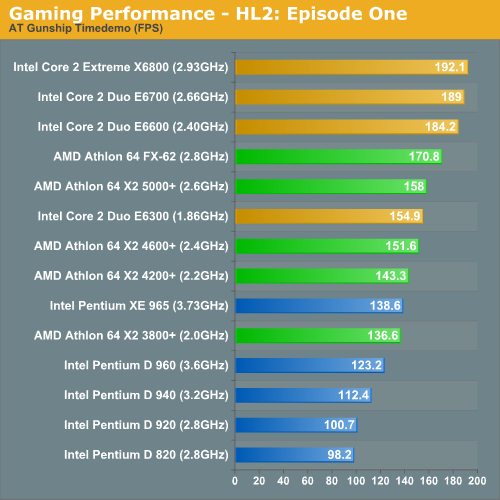Intel's Core 2 Extreme & Core 2 Duo: The Empire Strikes Back
by Anand Lal Shimpi on July 14, 2006 12:00 AM EST- Posted in
- CPUs
Gaming Performance using Quake 4, Battlefield 2 & Half Life 2 Episode 1
Our gaming performance analysis starts out with Quake 4 running at 1600 x 1200 with High Quality visual settings. We used version 1.2 of Quake 4 and SMP was enabled:

The performance advantage in Quake 4 starts off high, but not astronomical for the Core 2 processors. The Core 2 Extreme X6800 is just over 11% faster than the Athlon 64 FX-62, mainly because we're looking at it in a more GPU bound light than we have in the past. Regardless, it is a performance advantage and far better than the older days of NetBurst chips where Intel's best could barely keep up with AMD.
Looking at Battlefield 2 performance, Intel begins to improve its gaming performance lead as we are becoming more CPU bound:

The Core 2 Extreme X6800 now attains a 19% performance lead over the FX-62, and the E6600 manages a 10.9% advantage itself.
Next up we've got the recently released Half Life 2: Episode 1, running at default quality settings (auto detected with a pair of X1900 XTs installed) with the exception of AA and aniso being disabled. As with all of our gaming tests in this article we tested at 1600 x 1200:

Half Life 2: Episode 1 provided us with numbers closer to what we saw with Quake 4, the performance advantage here is just over 12% for the X6800 over the FX-62. With a couple of speed bumps, AMD could equal Intel's gaming performance here. But the real issue for AMD is the fact that the E6600 priced at $316, is able to outperform the FX-62 at over twice the price. The E6300 continues to provide a great value but isn't nearly as impressive as the rest of the Core 2 line.










202 Comments
View All Comments
invise - Friday, July 14, 2006 - link
According to page 3 "The Test", you used an Intel D975xBX motherboard (Intel 975X chipset) for the tests in the article. Yet in the picture of the Tuniq Tower on page 18 "Overclocking", there is clearly an Asus board with a gold/copper chipset heatsink, blue PCI-Express 16x slot, and alternating yellow and black DIMM slots. Which board is this? I suspect a P5WD2 or P5N32-SLI, just from looking at pictures online, but from what I can find neither of those has a gold/copper heatsink on the Northbridge.I'm curious because you got the board's FSB stable at 445 MHz, which is critical when working with a CPU with a low, locked multiplier. If any other users recognize the board please ID it.
spug1 - Friday, July 14, 2006 - link
I noticed that too Invise. Can we have some clarification as to whether you used the intel board, or the asus p5w-dh for the testing of conroe?!
cheerz, :)
JarredWalton - Friday, July 14, 2006 - link
Overclocking was done with the ASUS board. The benchmarks scores were tested on the Intel board as reported on page 3.Suraj - Friday, October 20, 2006 - link
What other parts did u change when overclocking? I'm very eager to know what exact parts u used when overclocking the e6600.Kiste - Friday, July 14, 2006 - link
Great review, as always. I have to admit though that I was hoping for a bit more with regard to i965 based mainboards.Gary Key - Friday, July 14, 2006 - link
We have a few P965 boards in house currently, however all of them are undergoing almost daily bios changes. They should be very solid from a performance viewpoint within 30 days but at this time they are still immature and any performance results shown with them are not final.
Wesley Fink - Friday, July 14, 2006 - link
You will see Conroe motherboard reviews the first of the week, and yes, there are 965 boards in the reviews.DrMrLordX - Friday, July 14, 2006 - link
Could you guys please do a mini-review of this chip? In particular, could you overclock it using a Tuniq Tower 120 or something and give us some idea of how high it will go? I've been wanting to know more about that proc since AM2 launched, but AMD has been doing a lousy job of getting them into retail channels.redpriest_ - Friday, July 14, 2006 - link
Very detailed, I loved it. But quick question: Your screenshots with cpuid have the stepping as a B1 stepping 5 Conroe - I bought a retail Conroe X6800, and it was a stepping 6 revB2 - and it "only" clocks to 3.466 ghz stably. 3.733 is unstable and 4 ghz is a no boot into Windows; so my question is - is that the stepping you used or was it just a screenshot from an older comparison?Wesley Fink - Friday, July 14, 2006 - link
Our review samples are all Stepping 5. We also have an earlier Stepping 4 unlocked E6700 that overclocks very well. We understood stepping 5 was the Retail stepping. We will clarify this with Intel later today.